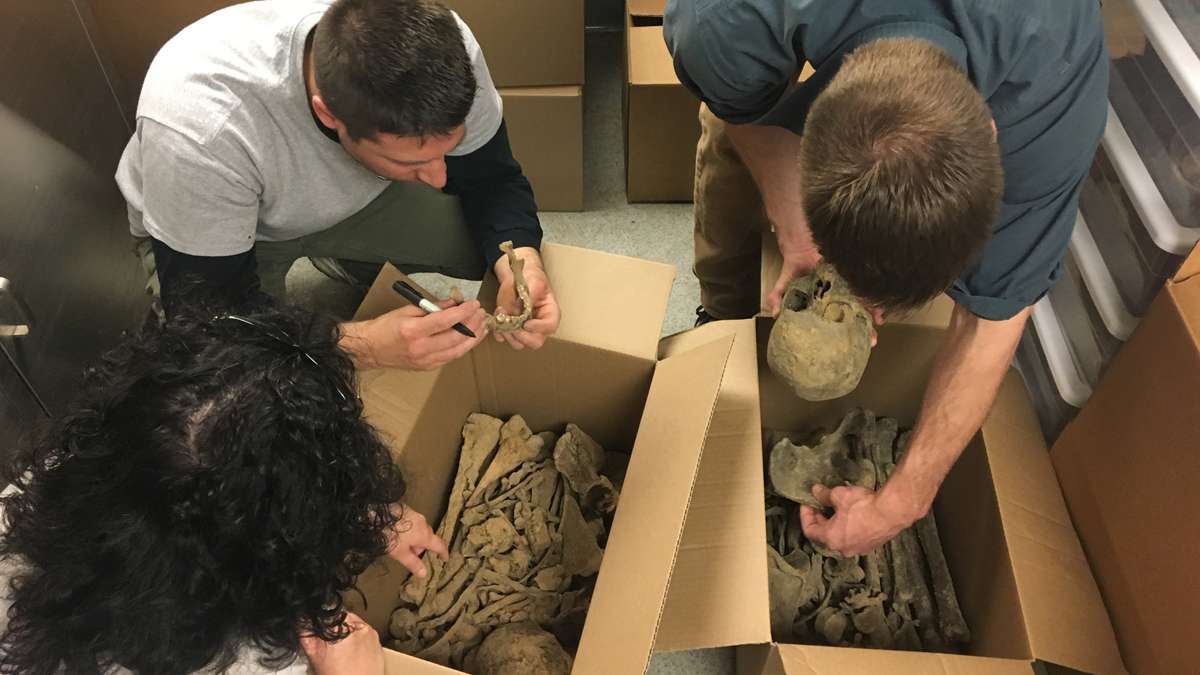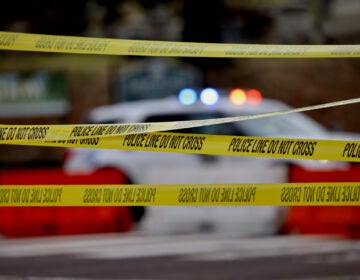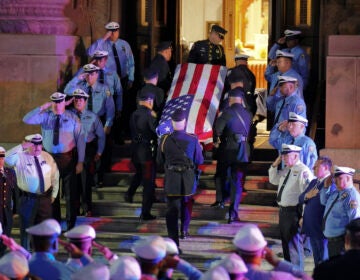Philly judge charts future for historic human remains found at construction site

Anthropologists and archaeologists meet at Kimberlee Moran's lab at Rutgers-Camden to review some of the remains excavated from 218 Arch St. in Philadelphia last month. (Elana Gordon/WHYY)
After months of uncertainty, a Philadelphia judge has outlined concrete steps for what will become of the remains of more than 300 people discovered in a former cemetery on a construction site in Old City.
Since workers began finding the bones in the fall, the remains have been mired in controversy about who’s responsible for them and how they’ve been handled.
On Monday, Orphans Court Judge Matthew Carrafiello issued a preliminary decree ordering developer PMC Property Group to work with the archaeology firm AECOM to locate, remove and transport the remains to a facility associated with Rutgers University “for further study, preservation and attempted identification.”
PMC must also fully cover the expenses of burying the remains at Mount Moriah Cemetery in Southwest Philadelphia by Aug. 1, 2020, according to the decree. In the meantime, the court has assumed jurisdiction over the remains and related artifacts.
PMC must submit public updates every 60 days and treat the remains respectfully, Carrafiello ordered. And, before he issues a final decree, the judge set an Oct. 30 public hearing for any interested party, such as a descendant, to weigh in on the process.
Establishing a protocol
To archaeology and preservation advocates, the ruling comes as a relief, setting a clearer foundation for similar finds in the future.
“The judge clearly said the court absolutely has legal, full legal jurisdiction over these remains and that PMC needed to come to the court to get permission to examine and relocate these remains,” said Mark Zecca, a former city lawyer who has been working with concerned archaeologists.
The remains, which date from the early 1700s through the mid-1800s, were part of a lost cemetery connected to First Baptist Church. The entire cemetery was supposed to have been moved more than a century ago to another plot on the outskirts of Philadelphia, but that didn’t happen.
Controversy over handling the remains arose because the discovery took place on private property as part of a private construction project. A representative of PMC, which is building a condominium on the land, has said the company was told that because the remains were not part of an active investigation, the city didn’t need to be involved.
And officials with the city have said they don’t have any authority to intervene.
“Once the ground is conveyed, the burial ground is closed,” Leonard Reuter, a lawyer with the city’s department of Licenses and Inspections, told the judge during an emergency hearing last month, citing an 1860 law that addresses the transfer of real estate containing a burial ground.
“The only time the city is compelled to get involved in a matter like this is if city property is involved or a public facility.”
Zecca, who strongly disagreed with that interpretation, contended that when the remains were first discovered, the developer was obligated to go to Orphans’ Court — the judicial division that oversees matters related to people, property and entities “incapable” of representing themselves.
And the city should have stepped in to make sure that the remains were respected, he said.
“Bones that are in a cemetery are not abandoned,” Zecca said earlier. “They’re held in trust by the cemetery. They’re not the property of the person that owns the land.”
Studying the remains
Earlier this year, PMC granted a crew of volunteer archaeologists — including some from Rutgers and the Mutter Museum — permission to lead a dig and then study the remains they found.
The company covered the moving expenses, and the crew has been examining the remains at a private warehouse in hopes of learning more about these early Philadelphians, the lives they lived and even who they were.
But by June, more questions loomed over the handling of remains on the construction site. It was reported that workers were still finding more bones and more coffins. The remains of about a dozen individuals from the March dig don’t appear to be accounted for, either. The developer since hired the archaeology firm, AECOM, to oversee the situation at the site, and they’ve been transporting the newly discovered remains to the Rutgers archaeologists.
This latest decree follows PMC’s decision last month to bring in AECOM and then submit a petition to Orphans’ Court for permission to exhume remains at the site and then relocate them.
PMC did not respond to WHYY’s request for comment, but Jonathan Stavin, executive vice president, told The Philadelphia Inquirer he was pleased with the decree and that “the judge didn’t order us to do anything that we didn’t intend to do already.”
For Doug Mooney, president of the Philadelphia Archaeological Forum and the one archaeologist on Philadelphia’s new Historic Preservation Task Force, the decree carries huge implications.
“Hopefully, it helps to put to rest the notion that there’s nothing that can be done, and that there’s no legal jurisdiction at play here,” said Mooney, whose group has also been drafting a city ordinance that would provide even more clarification on such issues. “It’s only a matter of time before another one of these unmarked cemeteries is hit by construction in Philadelphia.”
City lawyers, however, don’t see it that way, and sent the following statement in an email:
“Consistent with the city’s position at the hearing before the Orphans’ Court, the court did not impose any obligations upon the city with regard to any remains found at the site. Nevertheless, the city of Philadelphia continues to hope that any remains at 218 Arch St. are handled in a respectful manner.”
Long-buried tokens of life
Either way, volunteer archaeologist Kimberlee Moran of Rutgers University is “very happy” with the latest development. She and others have wanted clarity on their role in preserving and studying the remains. The 2020 deadline gives them time to apply for grants and further study what’s been found, she said.
And, at the moment, the inventory is overwhelming; since June, the remains of 170 others have been excavated and transferred to them; altogether, 330 sets of skeletal remains have been found.
“And there’s still more coming,” said Moran, who as of Thursday afternoon, received four recently excavated child coffins and two more boxes of bones from the site.
Despite the magnitude, it won’t take long to identify at least one of the individuals. A recently excavated coffin still has a name plate on it: Benjamin Britton, born in 1725 and died in 1782.
Other notable findings have included pieces of cloth from an infant’s shroud; a bone that might have signs of syphillus; a bone of someone who might have had rickets; a skull that was subjected to an autopsy long before autopsies were the norm; and, last but not least, a fully preserved mustache.
WHYY is your source for fact-based, in-depth journalism and information. As a nonprofit organization, we rely on financial support from readers like you. Please give today.




